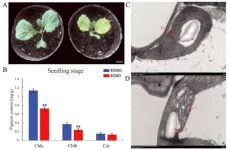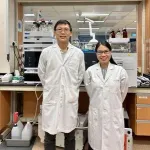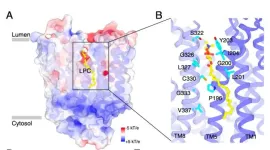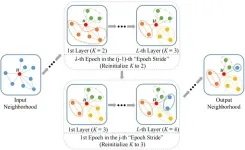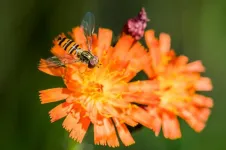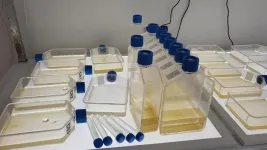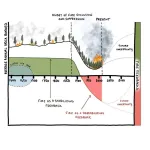(Press-News.org) A new study has uncovered a novel P-type PPR protein, BoYgl-2, which plays a crucial role in chloroplast RNA editing and chlorophyll biosynthesis in cabbage. This discovery sheds new light on the molecular mechanisms governing leaf color formation and chloroplast development, filling a significant knowledge gap in plant physiology. By identifying a spontaneous yellow-green leaf mutant and deciphering the function of BoYgl-2, the research paves the way for innovative crop breeding strategies that could enhance plant productivity and agricultural sustainability.
Leaf color is more than just an aesthetic trait—it is a vital agronomic characteristic that directly influences photosynthetic efficiency and crop yield. Variations in leaf pigmentation often stem from disrupted chloroplast function and impaired chlorophyll synthesis. While previous studies have highlighted the role of PPR proteins in chloroplast RNA editing and development, the precise mechanisms governing leaf color variation in cabbage remain largely unexplored. This knowledge gap has driven researchers to delve deeper into the genetic and molecular foundations of leaf pigmentation in cabbage.
On January 10, 2024, a study (DOI: 10.1093/hr/uhae006) published in Horticulture Research by scientists from Nanjing Agricultural University and the Chinese Academy of Agricultural Sciences unveiled the pivotal role of the BoYgl-2 gene in cabbage leaf color formation. The research focused on a naturally occurring yellow-green leaf mutant and provided a comprehensive genetic and molecular analysis to uncover the underlying mechanisms of this distinct phenotype.
The study identified and characterized a unique yellow-green leaf mutant (4036Y) in cabbage, exhibiting significantly reduced chlorophyll levels and abnormal chloroplast development during early leaf growth. Genetic analysis revealed that the trait is governed by a single recessive gene, BoYgl-2, which encodes a P-type PPR protein. Through fine mapping and sequencing, researchers pinpointed a 162-kb chromosomal deletion in the BoYgl-2 locus of the mutant. Functional complementation experiments confirmed the gene's role—reintroducing BoYgl-2 from normal-green leaf cabbage (4036G) successfully restored the wild-type phenotype, reinforcing its essential function in chloroplast development.
Further analysis of RNA editing revealed that in the mutant, the C-to-U editing efficiency of several crucial chloroplast genes—atpF, rps14, petL, and ndhD—was significantly compromised. However, in BoYgl-2 overexpression lines, the editing efficiency of these genes was restored to near-normal levels, mirroring those found in 4036G. Additionally, gene expression profiling showed substantial alterations in chloroplast-related pathways, with key genes involved in chloroplast development and chlorophyll biosynthesis notably downregulated. These findings provide a molecular blueprint for understanding how BoYgl-2 regulates chloroplast RNA editing and chlorophyll biosynthesis, offering new insights into the genetic architecture of leaf color formation in cabbage.
Dr. Xilin Hou, one of the study's corresponding authors, emphasized the significance of these findings, stating, "Our research not only deepens our understanding of the genetic and molecular mechanisms behind leaf color formation in cabbage but also opens new possibilities for crop improvement through targeted genetic interventions."
The discovery of BoYgl-2 and its role in chloroplast RNA editing carries profound implications for agricultural breeding. By developing precise genetic markers for BoYgl-2, plant breeders can streamline the selection process for desirable leaf color traits in cabbage and potentially other crops. This marker-assisted selection approach could accelerate breeding efforts, leading to enhanced crop varieties with optimized agronomic traits. Moreover, a deeper understanding of chloroplast RNA editing and chlorophyll biosynthesis unlocks new opportunities for genetic modifications aimed at improving photosynthetic efficiency and boosting crop yields. This research not only advances fundamental plant biology but also contributes to sustainable agriculture and global food security.
###
References
DOI
10.1093/hr/uhae006
Original Source URL
https://doi.org/10.1093/hr/uhae006
Funding information
This work was supported by a grant from the National Natural Science Foundation of China (31872948).
About Horticulture Research
Horticulture Research is an open access journal of Nanjing Agricultural University and ranked number one in the Horticulture category of the Journal Citation Reports ™ from Clarivate, 2022. The journal is committed to publishing original research articles, reviews, perspectives, comments, correspondence articles and letters to the editor related to all major horticultural plants and disciplines, including biotechnology, breeding, cellular and molecular biology, evolution, genetics, inter-species interactions, physiology, and the origination and domestication of crops.
END
Leaf color mysteries unveiled: the role of BoYgl-2 in cabbage
2025-02-12
ELSE PRESS RELEASES FROM THIS DATE:
NUS Medicine study: Inability of cells to recycle fats can spell disease
2025-02-12
Accumulation of fat molecules is detrimental to the cell. Researchers from the Yong Loo Lin School of Medicine, National University of Singapore (NUS Medicine), have made a breakthrough in understanding how our cells manage to stay healthy by recycling important fat molecules. Their study, published in the journal Proceedings of the National Academy of Sciences (PNAS), reveals how a protein called Spinster homolog 1 (Spns1) helps transport fats out of cell compartments known as lysosomes.
Led by Associate Professor Nguyen Nam Long, from the Department of Biochemistry and Immunology Translational Research Programme (TRP) at NUS Medicine, the team found that Spns1 is like a cellular ...
D2-GCN: a graph convolutional network with dynamic disentanglement for node classification
2025-02-12
Classic Graph Convolutional Networks (GCNs) often learn node representation holistically, which would ignore the distinct impacts from different neighbors when aggregating their features to update a node's representation. Disentangled GCNs have been proposed to divide each node's representation into several feature channels. However, current disentangling methods do not try to figure out how many inherent factors the model should assign to help extract the best representation of each node.
To solve the problems, a research team led by Chuliang WENG published their new ...
Female hoverflies beat males on long-distance migrations
2025-02-12
Male hoverflies are outflown by females when it comes to long-distance migration, new research shows.
Marmalade hoverflies leave northern Europe each autumn to escape the cold winter.
The study – by the University of Exeter – compared the number of males and females migrating at a northern point (Denmark) and further south (Spain).
At the northern point, 50% of hoverflies were male and 50% were female – but at the southern point about 90% were female, suggesting males are “poor long-distance fliers”.
“We carried out a range of tests and found females were better adapted for long-distance ...
Study finds consumer openness to smoke-impacted wines, offering new market opportunities
2025-02-12
CORVALLIS, Ore. – Certain groups of consumers appear to be open to drinking smoke-impacted wines, a finding in a new study that could provide market opportunities for winemakers increasingly dealing with the effects of wildfire smoke on grapes.
The study by researchers at Oregon State University and in New Zealand found that consumers, particularly those that like smokey flavors in food and beverages, are open to drinking smoke-impacted wines. They also found that the type of information on the label can modulate consumer acceptance.
“This ...
Why we need to expand the search for climate-friendly microalgae
2025-02-12
New research has highlighted microalgae’s capacity as a solution in the fight against climate change, but researchers warn that “smart microalgal bioprospecting” is needed to unlock its full potential.
The study highlights the vast, largely unexplored capacity of microalgae to mitigate CO2 emissions while driving sustainable industry.
“Microalgae have remarkable properties that make them an ideal tool for tackling climate change,” said lead author, PhD candidate Joan Labara Tirado from the University of Technology Sydney (UTS).
The review paper, The need for smart microalgal bioprospecting was ...
Fewer forest fires burn in North America today than in the past—and that's a bad thing
2025-02-12
Fewer wildfires burn in North American forests today than in previous centuries, increasing the risk of more severe wildfires, according to research published this week in Nature Communications. The findings may seem counterintuitive, but frequent low-lying surface fires often maintain balance in forests by reducing fuel sources across large areas.
The new study led by the Cooperative Institute for Research in Environmental Sciences (CIRES) at the University of Colorado Boulder and the U.S. Forest Service’s Rocky Mountain Research Station ...
Older people in England are happier now than before the COVID pandemic, new national study suggests
2025-02-12
Older people have greater general happiness, life satisfaction and sense of purpose than they did before the Covid-19 pandemic.
That’s according to a new study which tracked 3,999 over 50s in England for 11 years, published today in the peer-reviewed journal, Aging and Mental Health.
Analysing data to understand positive psychological well-being and depression within this group, an expert team from UCL (University College London), funded by the National Institute of Ageing, a consortium of UK government departments coordinated by the National Institute ...
Texas A&M chemist wins NSF CAREER Award
2025-02-11
Dr. Alison Altman, an assistant professor in the Texas A&M Chemistry Department, has received a National Science Foundation (NSF) CAREER Award, which supports early-career faculty in research and education. The award recognizes her work on underexplored elements of the periodic table and her dedication to teaching. For Altman, it’s a launchpad for future discoveries.
“It’s an honor to receive this award, as it acknowledges not just my research program but also my teaching efforts,” ...
Micro-nano plastics make other pollutants more dangerous to plants and intestinal cells
2025-02-11
Micro- and nanoscale plastic particles in soil and water can significantly increase how much toxic chemicals plants and human intestinal cells absorb, according to two new studies from Rutgers Health that raise fresh concerns about food safety from plastic pollution.
The first study in NanoImpact found that lettuce exposed to both nanoscale plastic particles and common environmental pollutants such as arsenic took up substantially more of the toxic substances than plants exposed to the pollutants, alone confirming the risks of polycontamination of our food chain. A companion study in Microplastics journal showed ...
Study of female genital tract reveals key findings
2025-02-11
Seeking to understand what constitutes a healthy vaginal microbiome, a global research collaboration that includes a Rutgers-New Brunswick scientist has reported a series of findings, including identifying which bacteria thwart vaginal disease and determining that microbiomes vary significantly across human populations.
Authors of the study, published in Trends in Microbiology, are part of a Belgium-based initiative called the Isala Sisterhood. Members of the group aim to inspire research on microbiomes worldwide by creating a “reference map” of vaginal microbiota. Launched in 2020 at the University of Antwerp, the project has expanded to include more than 3,000 ...
